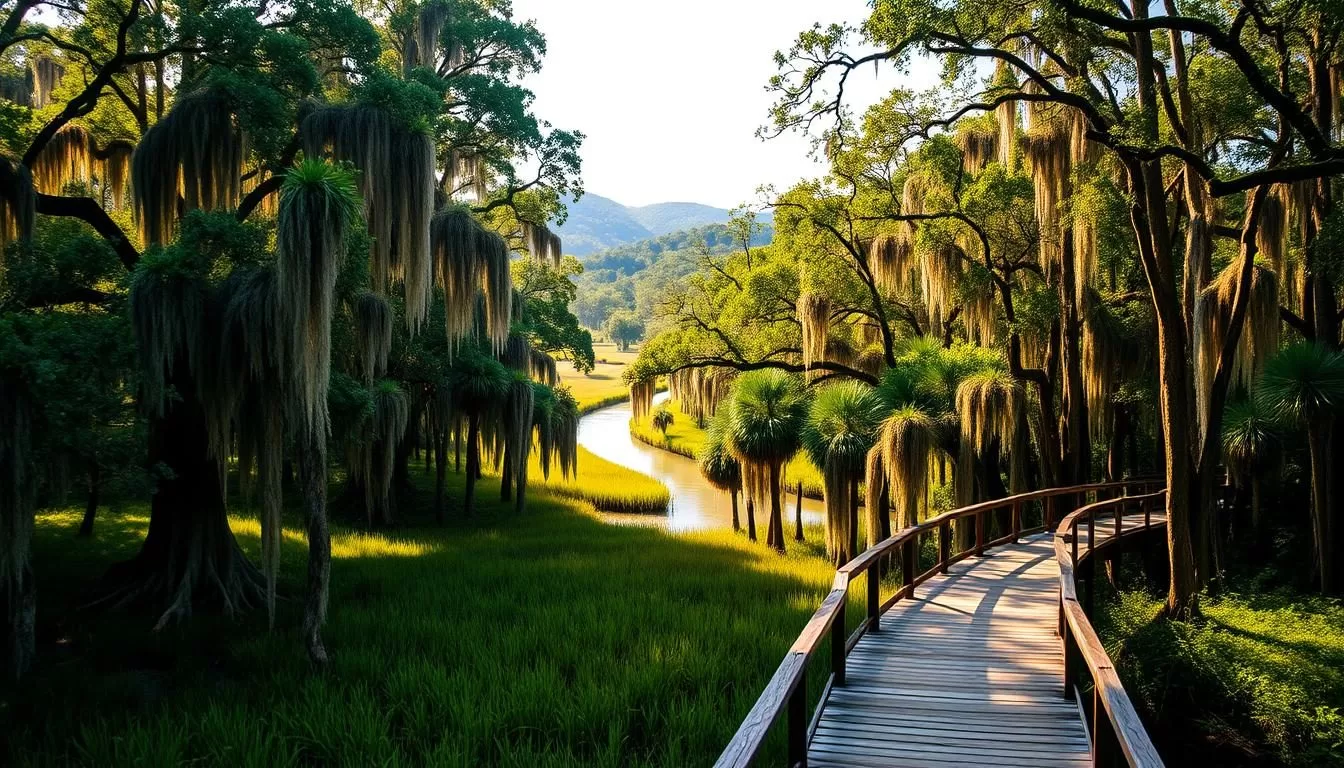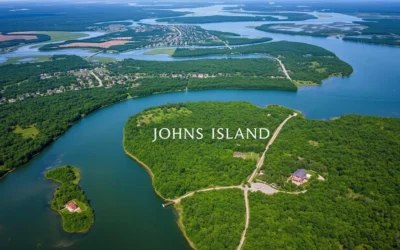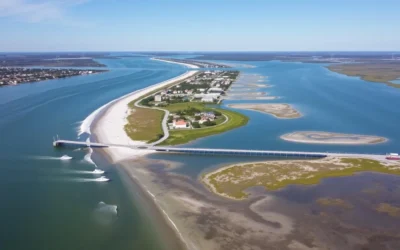✓ Accommodations✓ Flights✓ Rental Cars
Are you looking for a unique outdoor experience in the southeastern United States? Congaree National Park is a hidden gem that offers an unparalleled adventure amidst its old-growth bottomland hardwood forest.
With only 200,000 annual visitors, this national park is perfect for those seeking peace and tranquility in nature. You can explore the park’s 40 square miles of pristine wilderness through various activities, including hiking the famous Boardwalk Loop and paddling Cedar Creek.
Discover the park’s unique features, from its protected old-growth forests to the rare synchronous fireflies. Whether you’re a nature enthusiast or just looking for a day trip, Congaree National Park has something to offer.
Discovering Congaree National Park: A Hidden Gem in South Carolina
As you step into Congaree National Park, you’re about to enter one of the most biodiverse places on the planet. This national park is home to the largest old-growth hardwood bottomlands in the southeastern United States, boasting towering loblolly pines and bald cypress trees that can live over a thousand years.
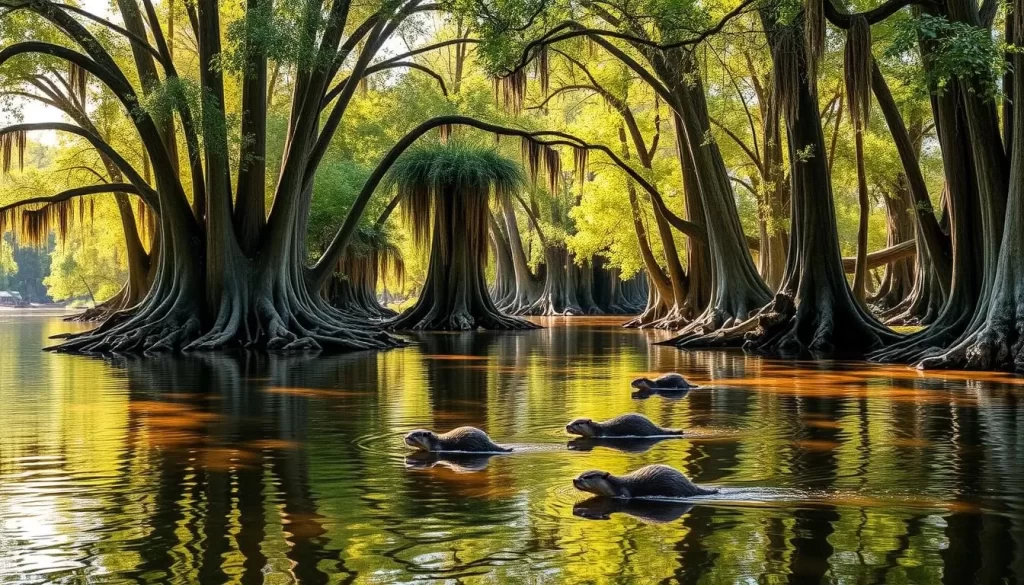
What Makes Congaree National Park Special
Congaree National Park is significant for being the largest intact expanse of old-growth bottomland hardwood forest remaining in the southeastern United States. The park’s unique bottomland ecosystem floods seasonally, creating a nutrient-rich environment that supports extraordinary biodiversity. This characteristic distinguishes it from swamps, which are permanently flooded.
| Ecosystem Characteristics | Bottomlands | Swamps |
|---|---|---|
| Flooding Pattern | Seasonal | Permanent |
| Biodiversity | Extraordinary | Varies |
The Unique Ecosystem of Congaree
The Congaree National Park ecosystem is characterized by its nutrient-rich soil and year-round warm temperatures, making it one of the tallest deciduous forests on the planet. This has earned it the nickname “Redwoods of the East.” The park is also a UNESCO Biosphere Region, recognized for its rare and diverse species.
The park’s rich history, from the Indigenous Congaree people to its role as a refuge for enslaved people seeking freedom during the Civil War, adds to its significance. Conservation efforts have protected this rare ecosystem from logging and development, preserving its natural beauty for future generations.
Exploring the Boardwalk Loop Trail: Congaree’s Most Popular Hike
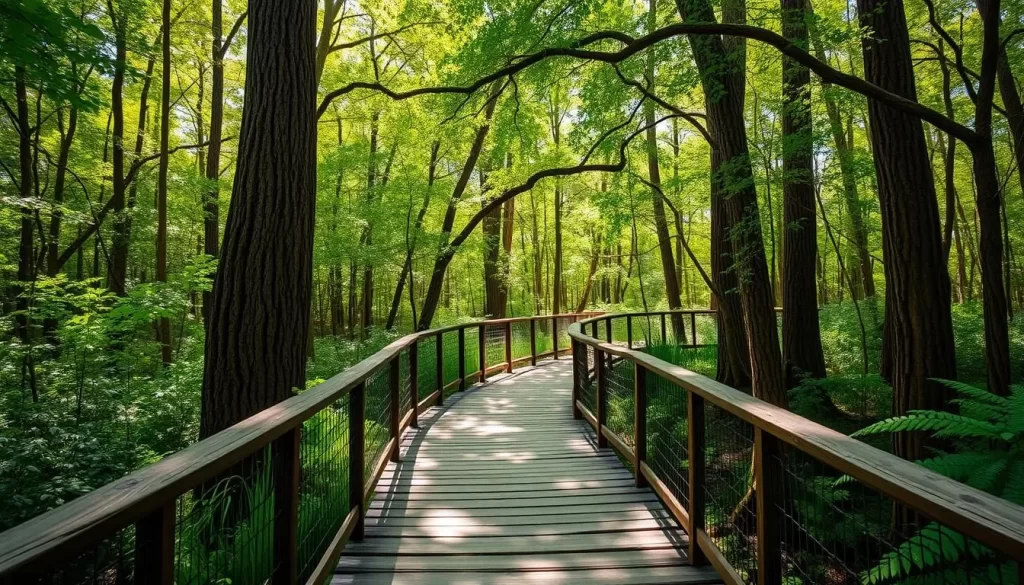
Congaree National Park’s Boardwalk Loop Trail is a 2.6-mile journey through a breathtaking cypress-tupelo forest, teeming with wildlife and natural wonders. This trail is not only the park’s most popular hike but also an accessible way to experience the unique ecosystem of Congaree National Park.
What to Expect on the Boardwalk Loop
As you embark on the Boardwalk Loop Trail, you’ll traverse a flat, wooden boardwalk that winds through a cypress-tupelo flat, parts of which are sometimes submerged in water. The trail is a 2.6-mile loop that departs from the Harry Hampton Visitor Center, where you can pick up an interpretive map to enhance your experience.
The map highlights points of interest along the way, including an abandoned moonshine still from Prohibition and dwarf palmetto plants. The elevated boardwalk allows you to explore the forest without disturbing the sensitive ecosystem, making it an ideal way to experience the natural beauty of Congaree National Park.
Wildlife and Plant Life You’ll Encounter
As you walk along the trail, keep an eye out for the diverse wildlife that inhabits the forest, including pileated woodpeckers, green anoles, and gray squirrels. The forest is also home to a variety of bird species, making it a paradise for birdwatchers.
One of the highlights of the trail is the Weston Lake overlook, where you can spot turtles and fish in the tannin-stained water. The trees surrounding the lake, including cypress and tupelo, are some of the tallest in the forest, creating a canopy that shelters the diverse flora and fauna.
Paddling Cedar Creek: A Unique Perspective of the Park
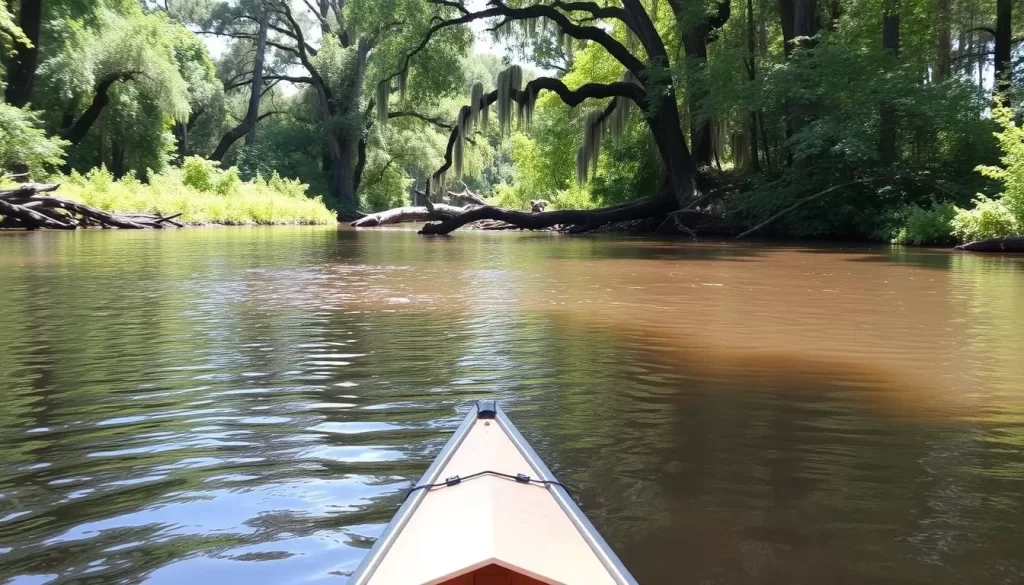
Experience the tranquility of Congaree National Park by paddling Cedar Creek, a journey that offers a unique and immersive way to explore the park’s diverse ecosystem.
Kayaking and Canoeing Options
The Cedar Creek Canoe Trail is a 15-mile (one-way) waterway that meanders through the park’s cypress forests, providing a peaceful and picturesque journey. Visitors can access the creek via the South Cedar Creek Canoe Landing, which features a gravel parking lot and a trail leading to a wooden platform for launching canoes or kayaks.
For those without their own equipment, several local outfitters offer rental services, including River Runner Outdoor Center, Palmetto Outdoors, J.K. Adventure Guides, and Carolina Outdoor Adventures.
Tips for a Successful Paddling Adventure
For a smooth and enjoyable experience, it’s recommended to paddle upstream first and then let the gentle current carry you back. Be prepared for potential obstacles such as downed trees, which may require you to navigate around them or turn back if they block your path.
Keep an eye out for the diverse wildlife that inhabits the area, including river otters, various bird species, and occasionally alligators in the park’s backcountry areas. Paddling Cedar Creek is a great way to experience the natural beauty of Congaree National Park.
Witnessing the Synchronous Fireflies: Nature’s Light Show
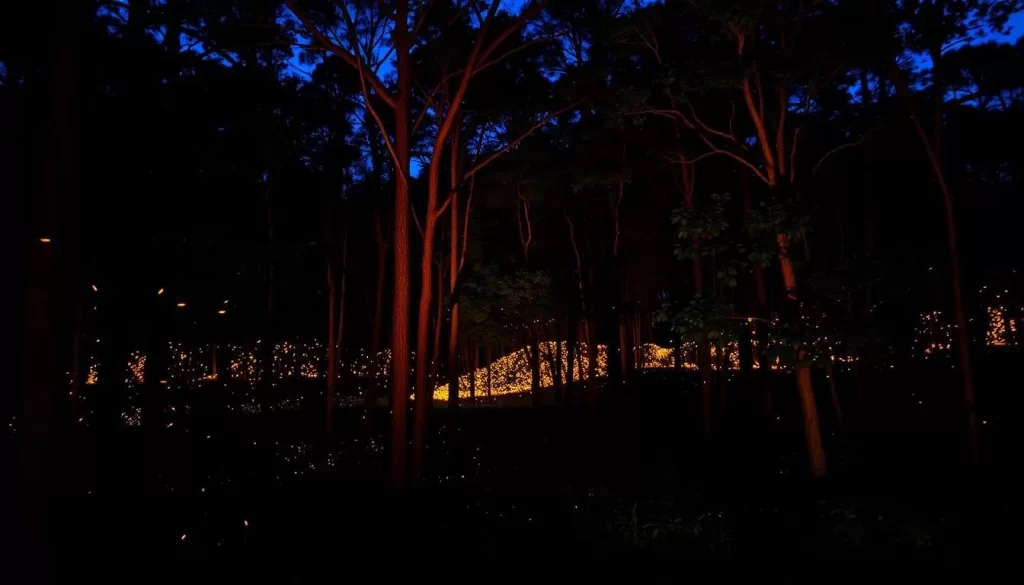
Congaree National Park transforms into a magical realm each summer with its synchronous firefly display. This rare natural phenomenon occurs for approximately two weeks in early summer, typically between mid-May and mid-June. The synchronous fireflies flash in unison as part of their mating ritual, creating a mesmerizing light show.
When and How to See the Fireflies
The synchronous firefly display in Congaree National Park is a spectacle not to be missed. The fireflies are active for about two weeks in early summer. The best time to witness this phenomenon is between 9 and 10 p.m. To avoid disturbing the insects, visitors are required to use red light filters on their flashlights. This species of firefly, one of only three in North America, makes this event truly unique.
Securing Permits and Planning Your Visit
To manage the large number of visitors, Congaree National Park requires a special vehicle pass for the firefly display. For the 2024 season, the viewing dates are May 16-25, and the lottery for vehicle passes opens from April 4 to April 11 on Recreation.gov. Planning ahead is crucial, as this event is extremely popular. Make sure to secure your pass in advance to witness the magical display of fireflies in the park.
By planning your visit to Congaree National Park during the synchronous firefly display, you’ll experience one of nature’s most enchanting phenomena. This event is a bucket-list experience for many nature enthusiasts, making it a year to remember.
Hiking Beyond the Boardwalk: Trails for Every Skill Level
Congaree National Park is a hiker’s paradise, with numerous trails that cater to different skill levels and interests. While the Boardwalk Loop is a must-visit, the park offers more for those willing to venture further.
The park’s diverse trails allow you to explore its rich ecosystems, from the bottomland forests to the cypress-tupelo flats. Whether you’re a casual walker or an experienced hiker, there’s a trail for you.
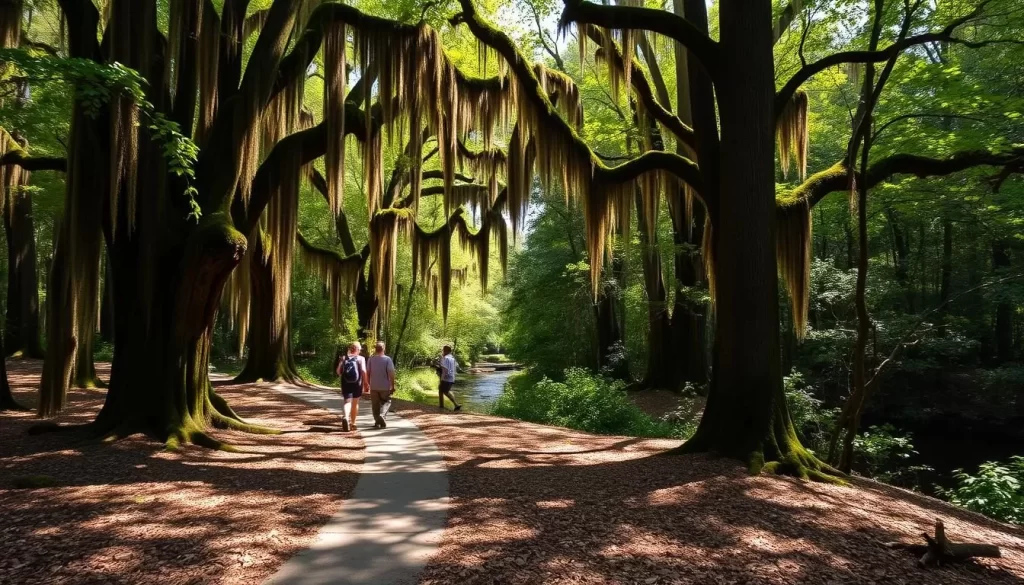
Weston Lake Loop Trail
The Weston Lake Loop Trail is a 4.5-mile trail that offers a more immersive experience through the bottomland forest and around the park’s largest oxbow lake, Weston Lake. This trail combines 2.3 miles of flat dirt path along Cedar Creek with the familiar Boardwalk Loop, making it an ideal choice for those looking for a slightly longer hike.
Kingsnake Trail for Wildlife Enthusiasts
For wildlife enthusiasts, the Kingsnake Trail is a 7.6-mile journey through a quieter section of Congaree’s cypress-tupelo flat. This trail is renowned for its excellent wildlife spotting opportunities, including birds, deer, opossums, and even the occasional mountain lion.
River Trail and Other Hiking Options
If you’re looking for a more challenging hike, the River Trail is an 11.1-mile out-and-back trail that leads to the Congaree River. Rated moderate due to some potentially difficult-to-follow portions, this trail is best suited for experienced hikers. Other trails within the park offer varying distances and difficulties, ensuring that every visitor can find a hike that suits their preferences.
When planning your hike, consider the seasonal conditions, as some trails may be inaccessible due to flooding. Being prepared with the right gear and knowledge will enhance your hiking experience in Congaree National Park.
Wildlife Watching in Congaree National Park
As you explore Congaree National Park, you’ll discover a rich tapestry of wildlife inhabiting the park‘s diverse ecosystems. The national park is home to a wide range of species, making it a haven for nature enthusiasts and photographers alike.
Birds and Mammals to Look For
Congaree National Park is renowned for its birdwatching opportunities, with species like the pileated woodpecker and the endangered red-cockaded woodpecker. You might also spot white-tailed deer, river otters, and bobcats. The park‘s old-growth forests and waterways support a variety of wildlife, including the elusive mountain lion.
- Pileated woodpeckers with their vibrant red crests
- White-tailed deer grazing in the forest
- River otters swimming in the waterways
Alligators and Reptiles: Safety and Viewing Tips
While exploring the park, be aware of the presence of alligators, particularly in the backcountry areas. It’s essential to keep a safe distance from water edges and any spotted alligators. The park is also home to venomous snakes like copperheads, rattlesnakes, and water moccasins. Staying on designated trails and being mindful of your surroundings can help ensure a safe and enjoyable visit.
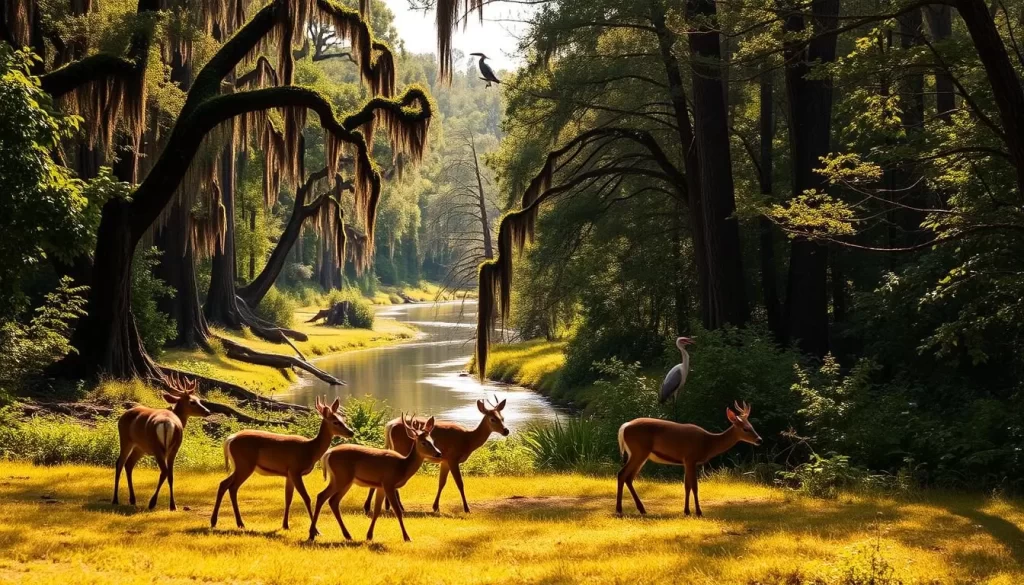
Camping Under Ancient Trees: Overnight Options
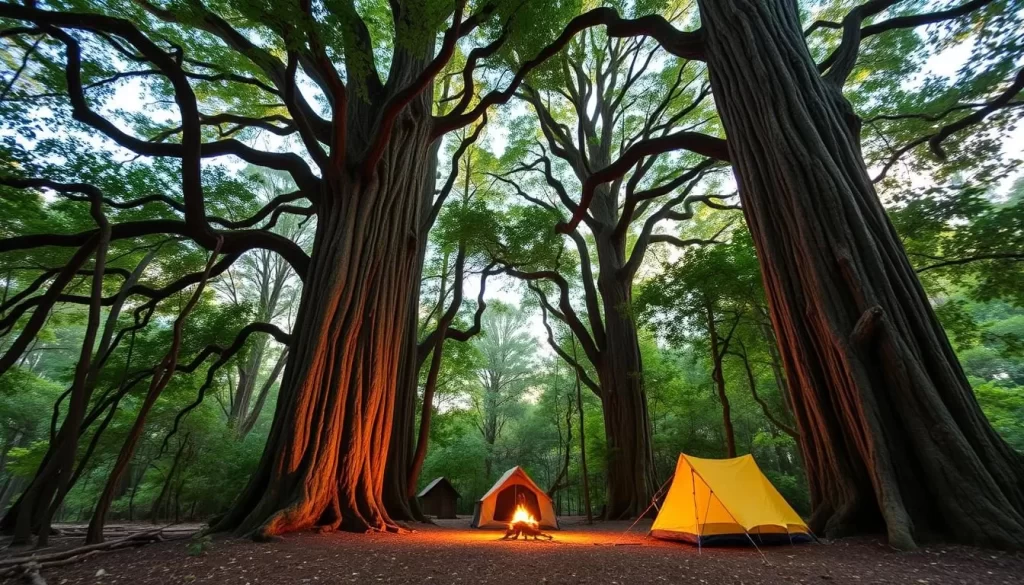
Camping in Congaree National Park offers a unique opportunity to connect with nature beneath the canopy of some of the tallest trees in the Eastern United States. Visitors can choose from two campgrounds or opt for backcountry camping for a more immersive experience.
Longleaf and Bluff Campgrounds
For those looking for a more convenient camping experience, Longleaf Campground is located near the park entrance road. It features two vault toilets but lacks running water. Reservations are essential and can be made up to six months in advance through Recreation.gov. Alternatively, Bluff Campground, situated about a mile from Longleaf, offers a more secluded experience, accessible only on foot. However, it has no facilities, making it ideal for those seeking a primitive camping experience.
Backcountry Camping for the Adventurous
For the more adventurous visitors, Congaree National Park also offers backcountry camping options. A free permit is required, which can be obtained at the park’s visitor center. This type of camping allows for a deeper immersion into the park’s wilderness, providing a truly unique experience. It’s essential to be well-prepared with plenty of supplies, as facilities are non-existent in backcountry areas.
When planning your camping trip to Congaree National Park, keep in mind that there are no RV camping facilities within the park. However, nearby private and state park campgrounds can accommodate RVs, offering an alternative for those with recreational vehicles.
Whether you choose to camp at Longleaf, Bluff, or in the backcountry, your time in Congaree National Park will be a memorable experience. With plenty of opportunities to connect with nature, you’ll find that camping under the ancient trees is an unforgettable adventure.
Best Time to Visit Congaree National Park
To make the most of your visit to Congaree National Park, it’s crucial to consider the time of year. The park offers unique experiences throughout the year, but certain seasons are more favorable than others.
Seasonal Highlights and Weather Considerations
Spring (March through May) is considered the best time to visit Congaree, with warm, pleasant temperatures and relatively bug-free conditions. This season is ideal for witnessing the synchronous fireflies in late May. In contrast, summer (June through August) is not recommended due to extreme heat, high humidity, and abundant mosquitoes. Fall (September through mid-November) offers pleasant temperatures and spectacular foliage, making it another excellent time to visit. The cypress trees turn fiery cinnamon and orange, while tupelos display scarlet and golden hues.
Avoiding Crowds and Mosquitoes
If you’re looking to avoid crowds and mosquitoes, consider visiting during the winter (late November through February). Although it’s the most likely time for flooding, the temperatures remain relatively warm, and insect activity is minimal. You can also plan your visit around the park’s frequent flood cycles, which occur approximately 10 times per year and can affect trail accessibility. By choosing the right season, you can have a more enjoyable and peaceful experience at Congaree National Park.
Planning Your Visit: Practical Information
Before you head to Congaree National Park, here are some practical details to consider. Planning your visit will ensure you make the most of your time at this beautiful national park.
How to Get to Congaree National Park
Congaree National Park is located in Kingville, South Carolina, making it easily accessible from Columbia, Charleston, or Charlotte, North Carolina. You can fly into one of these cities and then rent a car to get to the park. The drive from Columbia is less than half an hour, while Charleston and Charlotte are under two hours away. Having a rental car is necessary for accessing and exploring the park, as public transportation options are limited.
For visitors coming from afar, flying into Columbia Metropolitan Airport is the most convenient option. From there, renting a car and driving to the park is straightforward, with clear directions available from the airport.
| Airport | Distance to Congaree National Park | Approximate Drive Time |
|---|---|---|
| Columbia Metropolitan Airport | 30 minutes | Less than 1 hour |
| Charleston International Airport | 1 hour 45 minutes | Under 2 hours |
| Charlotte Douglas International Airport | 1 hour 55 minutes | Under 2 hours |
Park Facilities and Visitor Center
The Harry Hampton Visitor Center is the heart of Congaree National Park, providing visitors with essential information, souvenirs, and access to the Boardwalk Loop trail. At the visitor center, you can find interpretive displays, get assistance from park rangers, and pick up trail maps. The center is well-equipped to help you plan your day and make the most of your visit.
You’ll also find picnic facilities within the park, but it’s a good idea to bring plenty of supplies as food options are limited. Parking can fill up by mid-day during busy periods, so arriving early is recommended.
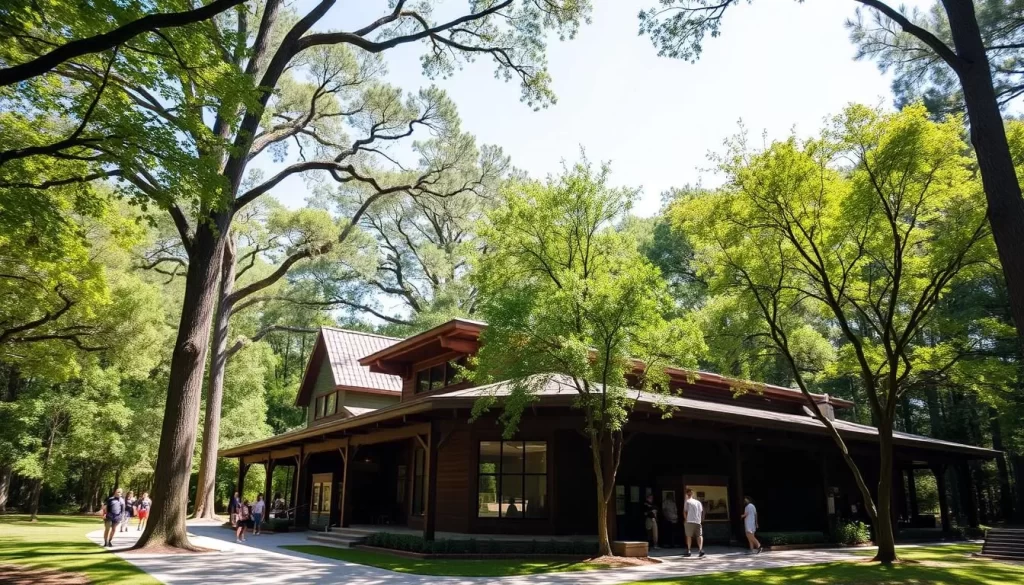
Where to Stay Near Congaree National Park

To make the most of your trip to Congaree National Park, consider staying in nearby Columbia for a wide range of hotels and amenities. Columbia is a great homebase when visiting Congaree, with plenty of hotels and restaurants within a 30-minute drive to the park entrance.
Accommodation Options in Columbia
Columbia offers a variety of upscale and mid-range accommodations. For a luxurious stay, consider the Hotel Trundle, which offers complimentary beer or wine upon check-in and made-to-order breakfast.
Alternatively, the Graduate Columbia provides a unique blend of Southern charm and modern amenities, within walking distance to local restaurants and attractions.
Other Nearby Lodging Choices
For a more intimate experience, the 1425 Inn is a historic home turned boutique hotel, offering continental breakfast and complimentary snacks. Visitors can also explore other nearby towns and private accommodations for a more secluded stay. It’s advisable to book your accommodations early, especially during peak seasons like the synchronous firefly event, when lodging fills quickly.
Conclusion: Why Congaree National Park Deserves Your Visit
Despite being one of the lesser-visited national parks, Congaree National Park in South Carolina is a treasure trove of natural wonders. This park boasts the largest intact expanse of old-growth bottomland hardwood forest in the United States, offering an unparalleled biodiversity. Visitors can easily explore its highlights in a day via well-maintained hiking trails and boardwalks. Enjoy a leisurely stroll on the Boardwalk Loop, or paddle along Cedar Creek for a unique perspective. With special events like the synchronous firefly display, timing your visit can make the experience even more magical.
The above is subject to change.
Check back often to TRAVEL.COM for the latest travel tips and deals.
